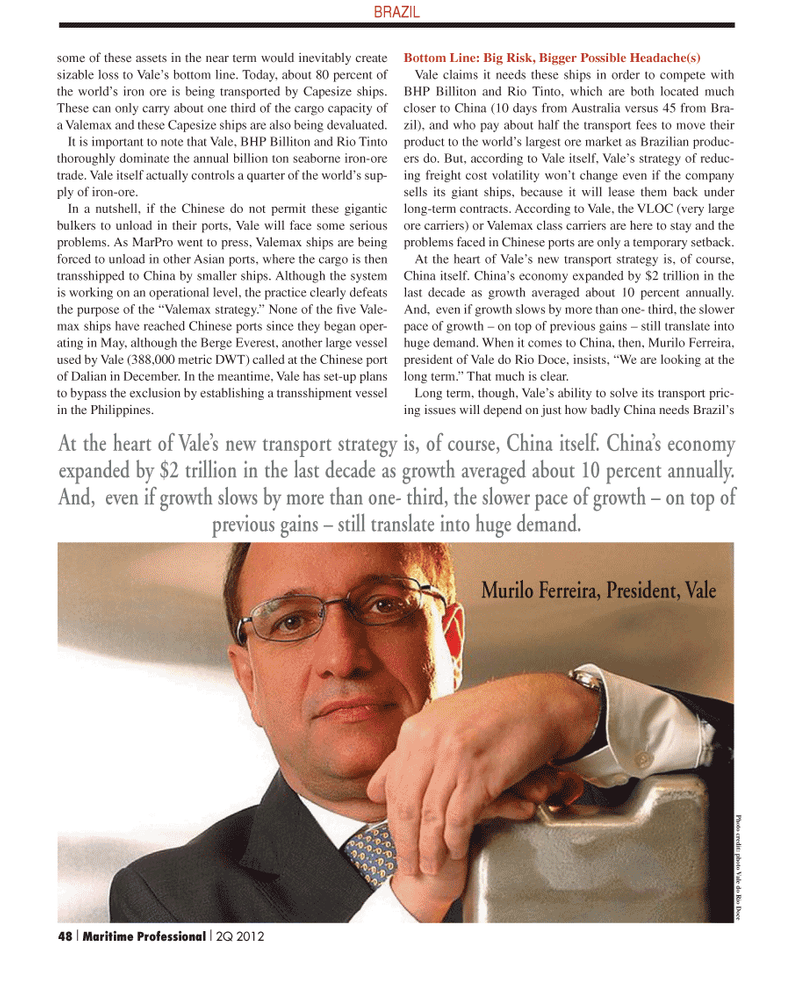
Page 48: of Maritime Logistics Professional Magazine (Q2 2012)
Maritime Risk
Read this page in Pdf, Flash or Html5 edition of Q2 2012 Maritime Logistics Professional Magazine
some of these assets in the near term would inevitably create sizable loss to Vale’s bottom line. Today, about 80 percent of the world’s iron ore is being transported by Capesize ships.
These can only carry about one third of the cargo capacity of a Valemax and these Capesize ships are also being devaluated.
It is important to note that Vale, BHP Billiton and Rio Tinto thoroughly dominate the annual billion ton seaborne iron-ore trade. Vale itself actually controls a quarter of the world’s sup- ply of iron-ore.
In a nutshell, if the Chinese do not permit these gigantic bulkers to unload in their ports, Vale will face some serious problems. As MarPro went to press, Valemax ships are being forced to unload in other Asian ports, where the cargo is then transshipped to China by smaller ships. Although the system is working on an operational level, the practice clearly defeats the purpose of the “Valemax strategy.” None of the fi ve Vale- max ships have reached Chinese ports since they began oper- ating in May, although the Berge Everest, another large vessel used by Vale (388,000 metric DWT) called at the Chinese port of Dalian in December. In the meantime, Vale has set-up plans to bypass the exclusion by establishing a transshipment vessel in the Philippines.
Bottom Line: Big Risk, Bigger Possible Headache(s)
Vale claims it needs these ships in order to compete with
BHP Billiton and Rio Tinto, which are both located much closer to China (10 days from Australia versus 45 from Bra- zil), and who pay about half the transport fees to move their product to the world’s largest ore market as Brazilian produc- ers do. But, according to Vale itself, Vale’s strategy of reduc- ing freight cost volatility won’t change even if the company sells its giant ships, because it will lease them back under long-term contracts. According to Vale, the VLOC (very large ore carriers) or Valemax class carriers are here to stay and the problems faced in Chinese ports are only a temporary setback.
At the heart of Vale’s new transport strategy is, of course,
China itself. China’s economy expanded by $2 trillion in the last decade as growth averaged about 10 percent annually.
And, even if growth slows by more than one- third, the slower pace of growth – on top of previous gains – still translate into huge demand. When it comes to China, then, Murilo Ferreira, president of Vale do Rio Doce, insists, “We are looking at the long term.” That much is clear.
Long term, though, Vale’s ability to solve its transport pric- ing issues will depend on just how badly China needs Brazil’s
BRAZIL
Photo cr edit: photo
V ale do Rio Doce
At the heart of Vale’s new transport strategy is, of course, China itself. China’s economy expanded by $2 trillion in the last decade as growth averaged about 10 percent annually.
And, even if growth slows by more than one- third, the slower pace of growth – on top of previous gains – still translate into huge demand.
Murilo Ferreira, President, Vale 48 I Maritime Professional I 2Q 2012
MP #2 34-49 NEW STYLES.indd 48 5/4/2012 5:16:20 PM

 47
47

 49
49
